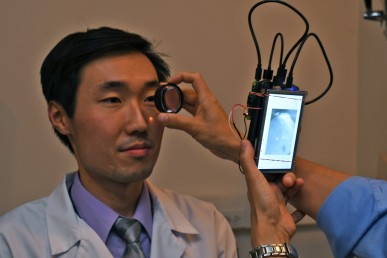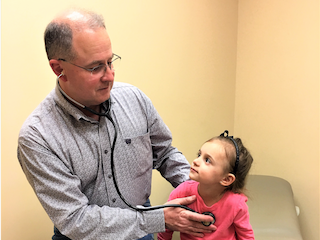News Clips
Farmers Turn to Tractor Hacking to Fight Corporate Gouging
Reports that American farmers are turning to foreign hackers just so they are able to work on equipment sold to them by John Deere shine light on a new problem in the era of software-controlled durable goods. In a bygone era, it wouldn’t be uncommon to find a grease-covered farmer working his tractor over to avoid costly downtime on the farm, sometimes even employing jerry-rig solutions meant to hold just long enough to get through the growing season. But as tractors, like everything else, become more technologically advanced, companies like John Deere are installing locks that make it impossible for certain maintenance to be performed without the help of a costly technician...
- Login to post comments
Who’s Logging Your Face?
In 1892, Sir Francis Galton published a treatise in which he argued that the patterns on our fingers were “an incomparably surer criterion of identity than any other bodily feature.” Today, fingerprinting is ubiquitous. But the limits of the technique are clear: Fingerprinting is a targeted, one-off process whereby a single person is identified, typically through an in-person or on-site interaction. Advanced face recognition, on the other hand, lets police identify people from far away and without interacting with them...
- Login to post comments
EHR Optimization: Necessary Because EHRS Are Never “Done”
Why, if over 95 percent of hospitals have implemented EHRs, are so many planning to invest in improvements or replacements this year? A new Healthcare IT News survey of hospital executives showed that 24 percent are conducting a major EHR system upgrade, and 21 percent are replacing their EHR at one or more sites. KPMG’s survey of CHIME members last month found that at least 38 percent of CIOs are investing in EHR optimization projects this year; in fact, they plan to spend more on EHR optimization than any other area of HIT. These numbers are huge when you consider that most hospital EHRs are newer versions implemented to meet MU attestation requirements...
- Login to post comments
A New Treatment for Antibiotic Resistant Bacteria and Infectious Disease
A study, published in the American Journal of Respiratory and Critical Care Medicine, describes a new treatment pathway for antibiotic resistant bacteria and infectious diseases with benefits for patients and health care providers. Researchers from the University of Birmingham and Newcastle University found that the unusual approach of removing antibodies from the blood stream reduced the effects of chronic infections, the requirement for days spent in hospital and the use of antibiotics...
- Login to post comments
An Antibiotic-Resistant Superbug Is Silently Spreading through UK Hospitals
Lying in a hospital bed, four months pregnant, Emily Morris felt only terror. She had caught a urinary tract infection and it was resistant to common antibiotics. Doctors needed to treat it as it could harm the baby, but the only drugs that could work hadn’t been tested on pregnant women before; the risks were unknown. Overwhelmed, Emily and her husband were asked to make a decision. A few hours later, gripping each other’s arms, they decided she should be given the drugs...
- Login to post comments
Kitware Prepares to Share Results of Dental Shape Analysis Research
 Kitware detailed plans to share preliminary results of ongoing research at the 95th General Session & Exhibition of the International Association for Dental Research (IADR). Kitware Technical Leader Beatriz Paniagua, Ph.D., will present the results in “Continuous 4D Shape Analysis of Mandibular Changes” at an oral session on temporomandibular joint disorders (TMD). The session, TMD Imaging Advances in Craniofacial Biology and Orthodontics, will take place Friday, March 24, 2017, in Moscone West in San Francisco, California...
Kitware detailed plans to share preliminary results of ongoing research at the 95th General Session & Exhibition of the International Association for Dental Research (IADR). Kitware Technical Leader Beatriz Paniagua, Ph.D., will present the results in “Continuous 4D Shape Analysis of Mandibular Changes” at an oral session on temporomandibular joint disorders (TMD). The session, TMD Imaging Advances in Craniofacial Biology and Orthodontics, will take place Friday, March 24, 2017, in Moscone West in San Francisco, California...
- Login to post comments
Philippines National Telehealth Center Leverages Innovative Open Solutions to Provide Equitable Access to Quality Healthcare
 OpenGov had the opportunity to speak to Dr. Portia Grace Fernandez-Marcelo, Director of the UP (University of Philippines) Manila-National Telehealth Center (NTHC) about using ICT to provide equitable access to quality healthcare for all, specially in isolated and disadvantaged communities. NTHC is one of the pioneers in the Philippines developing cost-effective ICT tools and innovations for improving healthcare and deploying solutions in communities where they are required most urgently...
OpenGov had the opportunity to speak to Dr. Portia Grace Fernandez-Marcelo, Director of the UP (University of Philippines) Manila-National Telehealth Center (NTHC) about using ICT to provide equitable access to quality healthcare for all, specially in isolated and disadvantaged communities. NTHC is one of the pioneers in the Philippines developing cost-effective ICT tools and innovations for improving healthcare and deploying solutions in communities where they are required most urgently...
- Login to post comments
3D Printing the Next Five Years by Prof. Joshua Pearce
 3-D printing should have been here 20 years ago. If my generation had had access to 3-D printers in high school, we would be technical wizards by now. Unfortunately, 3-D printing was locked away by patents, which effectively limited access to rapid prototyping to large corporate R&D centers. I am sure the hundreds of thousands of dollars invested in those early machines paid dividends, but they barely scratched the surface of the potential of additive manufacturing. As readers of 3-D Printing Industry know, we are finally starting to see the potential now...
3-D printing should have been here 20 years ago. If my generation had had access to 3-D printers in high school, we would be technical wizards by now. Unfortunately, 3-D printing was locked away by patents, which effectively limited access to rapid prototyping to large corporate R&D centers. I am sure the hundreds of thousands of dollars invested in those early machines paid dividends, but they barely scratched the surface of the potential of additive manufacturing. As readers of 3-D Printing Industry know, we are finally starting to see the potential now...
- Login to post comments
Can a 3D Printing Network for VA Hospitals Realize Ambitions for Customized Prosthetics?
 Stratasys has established a 3D printing lab network as part of an agreement with Center for Innovation at the Department of Veterans Affairs. The move signals the medtech company’s ambitions to move customized prosthetics into the mainstream of healthcare. The agreement with the Center for Innovation at the Department of Veterans Affairs will make five hospitals part of the initial network in Puget Sound, San Antonio, Albuquerque, Orlando, and Boston...
Stratasys has established a 3D printing lab network as part of an agreement with Center for Innovation at the Department of Veterans Affairs. The move signals the medtech company’s ambitions to move customized prosthetics into the mainstream of healthcare. The agreement with the Center for Innovation at the Department of Veterans Affairs will make five hospitals part of the initial network in Puget Sound, San Antonio, Albuquerque, Orlando, and Boston...
- Login to post comments
A Pocket-Sized Retina Camera, No Dilating Required
 It’s the part of the eye exam everyone hates: the pupil-dilating eye drops. The drops work by opening the pupil and preventing the iris from constricting in response to light and are often used for routine examination and photography of the back of the eye. The drops sting, can take up to 30 minutes to work, and cause blurry vision for several hours afterwards, often making them inconvenient for both patient and doctor. Now, researchers at the University of Illinois at Chicago College of Medicine and Massachusetts Eye and Ear/Harvard Medical School have developed a cheap, portable camera that can photograph the retina without the need for pupil-dilating eye drops...
It’s the part of the eye exam everyone hates: the pupil-dilating eye drops. The drops work by opening the pupil and preventing the iris from constricting in response to light and are often used for routine examination and photography of the back of the eye. The drops sting, can take up to 30 minutes to work, and cause blurry vision for several hours afterwards, often making them inconvenient for both patient and doctor. Now, researchers at the University of Illinois at Chicago College of Medicine and Massachusetts Eye and Ear/Harvard Medical School have developed a cheap, portable camera that can photograph the retina without the need for pupil-dilating eye drops...
- Login to post comments
A 40-Year 'Conspiracy' at the VA
 Four decades ago, in 1977, a conspiracy began bubbling up from the basements of the vast network of hospitals belonging to the Veterans Administration. Across the country, software geeks and doctors were puzzling out how they could make medical care better with these new devices called personal computers. Working sometimes at night or in their spare time, they started to cobble together a system that helped doctors organize their prescriptions, their CAT scans and patient notes, and to share their experiences electronically to help improve care for veterans...
Four decades ago, in 1977, a conspiracy began bubbling up from the basements of the vast network of hospitals belonging to the Veterans Administration. Across the country, software geeks and doctors were puzzling out how they could make medical care better with these new devices called personal computers. Working sometimes at night or in their spare time, they started to cobble together a system that helped doctors organize their prescriptions, their CAT scans and patient notes, and to share their experiences electronically to help improve care for veterans...
- Login to post comments
A New Kind of Doctor's Office Charges a Monthly Fee and Doesn't Take Insurance — and It Could Be the Future of Medicine
 Dr. Bryan Hill spent his career working as a pediatrician, teaching at a university, and working at a hospital. But in March 2016, he decided he no longer wanted a boss. He took some time off, then one day he got a call asking if he'd be up for doing a house call for a woman whose son was sick. He agreed, and by the end of that visit, he realized he wanted to treat patients without dealing with any of the insurance requirements. Then he learned about a totally different way to run a doctor's office...
Dr. Bryan Hill spent his career working as a pediatrician, teaching at a university, and working at a hospital. But in March 2016, he decided he no longer wanted a boss. He took some time off, then one day he got a call asking if he'd be up for doing a house call for a woman whose son was sick. He agreed, and by the end of that visit, he realized he wanted to treat patients without dealing with any of the insurance requirements. Then he learned about a totally different way to run a doctor's office...
- Login to post comments
Peer into the Post-Apocalyptic Future of Antimicrobial Resistance
Aout 4 million years ago, a cave was forming in the Delaware Basin of what is now Carlsbad Caverns National Park in New Mexico. From that time on, Lechuguilla Cave remained untouched by humans or animals until its discovery in 1986—an isolated, pristine primeval ecosystem. When the bacteria found on the walls of Lechuguilla were analyzed, many of the microbes were determined not only to have resistance to natural antibiotics like penicillin, but also to synthetic antibiotics that did not exist on earth until the second half of the twentieth century...
- Login to post comments
Peer into the Post-Apocalyptic Future of Antimicrobial Resistance
Aout 4 million years ago, a cave was forming in the Delaware Basin of what is now Carlsbad Caverns National Park in New Mexico. From that time on, Lechuguilla Cave remained untouched by humans or animals until its discovery in 1986—an isolated, pristine primeval ecosystem. When the bacteria found on the walls of Lechuguilla were analyzed, many of the microbes were determined not only to have resistance to natural antibiotics like penicillin, but also to synthetic antibiotics that did not exist on earth until the second half of the twentieth century...
- Login to post comments
PA Patient Safety Report: Health IT Contributed to 889 Medication-Error Events in Six Months
 In the first six months of 2016, Pennsylvania healthcare facilities reported 889 medication-error events that indicated health IT as a contributing factor, according to a report from the Pennsylvania Patient Safety Authority. The report noted that the most frequently reported errors included dose omission, wrong dose or overdosage, and extra dose; the most commonly reported systems involved were the computerized prescriber order entry (CPOE) and the pharmacy systems...
In the first six months of 2016, Pennsylvania healthcare facilities reported 889 medication-error events that indicated health IT as a contributing factor, according to a report from the Pennsylvania Patient Safety Authority. The report noted that the most frequently reported errors included dose omission, wrong dose or overdosage, and extra dose; the most commonly reported systems involved were the computerized prescriber order entry (CPOE) and the pharmacy systems...
- Login to post comments